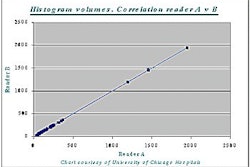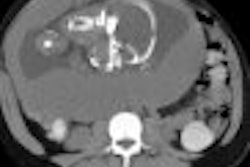SAN FRANCISCO - Despite recent controversy over CT and radiation dose in the pediatric population, the modality still has a great deal to offer for the detection of chest trauma in children, according to a presentation at the American Society of Emergency Radiology conference on Wednesday.
"Conventional radiography remains the study of choice for initial screening of complications to identify life-threatening injury [in children]. It also has value when assessing gas exchange capability of the lungs and in assessing tube and catheter location," said Dr. Carlos Sivits, professor of radiology at Case Western Reserve School of Medicine in Cleveland.
However, "CT is a better test for injury detection and quantification of parenchymal and pleural abnormalities. It also has greater specificity for mediastinal hemorrhage, and offers more precise localization for thoracotomy tubes," he added.
Radiation dose is an important issue that must be addressed, Sivits said. He pointed out some of the crucial differences between children and adult patients, summarizing them under one main theme: "Children are not just small adults."
At his institution, the CT protocol for pediatric patients includes a smaller field-of-view, thinner collimation, a lower dose of contrast media, and decreased milliampere (mA), Sivits said. For example, in a patient who is less than 6 years old, collimation is set at 4 mm, while the mA is at 70. For a patient between the ages of 6 and 12, the collimation is set at 8 mm and the mA is between 80 and 100. Intravenous contrast is given at 2 cc/kg with a maximum of 120 cc and an injection rate of 60 seconds.
"We really need to watch the mA," Sivits cautioned. "A lot of the mA that we see that comes from outside our hospital is in the 200 to 300 range."
Another consideration is pediatric anatomy. Children are anaplastic, with very pliable bony and cartilagenous structures. As a result, it’s not uncommon to see significant intrathoracic injuries without any overlying bony injuries, Sivits said. Physiologically, children have smaller circulating bloodlines, small blood vessels, and enhanced vasoconstrictive response. They may also experience greater physiologic derangement with less blood loss than adults.
Sivits outlined some of the most commonly seen chest injuries in pediatric patients in an emergency setting, starting with chest wall injury.
"We often see significant thoracic injury without any overlying bony injury," he said. "However, rib fractures may result in injury. A fractured rib can puncture a small vessel and result in hemothoracices. They can puncture a lung and result in parenchymal hemorrhage and laceration."
Rib fractures in infants can have a special significance: Unless there is a good mechanism of injury, one should think of abuse, Sivits said. These fractures are characteristically posterior and are not easily seen on conventional radiography, he added.
Other causes of chest trauma that Sivits highlighted are:
- Parenchymal injury -- These can result from direct lung compression by blunt forces, shearing forces, or perforation of a lung by fractured ribs. Parenchymal laceration is characterized by small, partially blood-filled air cavities that are best seen with a CT scan.
- Thoracic air leak -- If the air leak is large enough, it can result in tension pneumothorax, which is a life-threatening injury. Again, a CT exam is better for early detection because a pneumothorax or pneumomediastinum may be difficult to detect on a supine x-ray.
- Hemothorax -- This hemorrhage in the pleural space generally arises from the laceration of low-pressure pulmonary vessels. CT is useful in identifying and quantifying small to moderate-sized hemothoracices, which may not be identified with a chest x-ray.
- Esophageal injury -- Typically associated with major compressive injury, x-ray and CT findings tend to be nonspecific. A barium swallow or esophagoscopy may be more useful.
- Great vessel injury -- Chest x-ray can be used as a screening technique for the rare occurrence of the disruption of the aorta, but as x-ray lacks specificity, CT is the study of choice.
Sivits pointed out that CT has its limitations: It’s not very sensitive for cardiac injury and it’s not a specific test for esophageal trauma.
Session moderator Dr. Charles Mueller asked Sivits to comment on the studies that appeared in the American Journal of Roentgenology declaring that most children who undergo CT are exposed to excessively high radiation doses.
"Of the two papers published, one had to do with a theoretical model of cancer risk utilizing mA in the 400 range. I don’t think anybody in this country is using that range [for pediatric imaging], or at least I hope they don’t," Sivits said. "Keeping the mA down is essential. Even an mA setting in the 200 to 250 range is a lot more than you need."
By Shalmali Pal
AuntMinnie.com staff writer
March 15, 2001
Related Reading
Study sparks fears over kids’ exposure to CT radiation, February 13, 2001
CT radiation exposure higher than necessary in children, January 23, 2001
Digital radiography can improve detection of infant abuse, November 28, 2000
Click here to post your comments about this story. Please include the headline of the article in your message.
Copyright © 2001 AuntMinnie.com



















